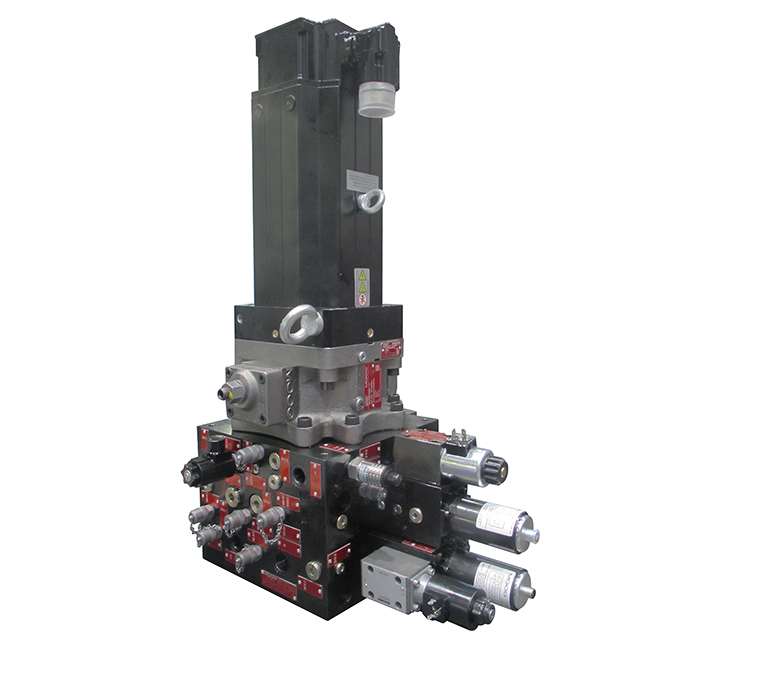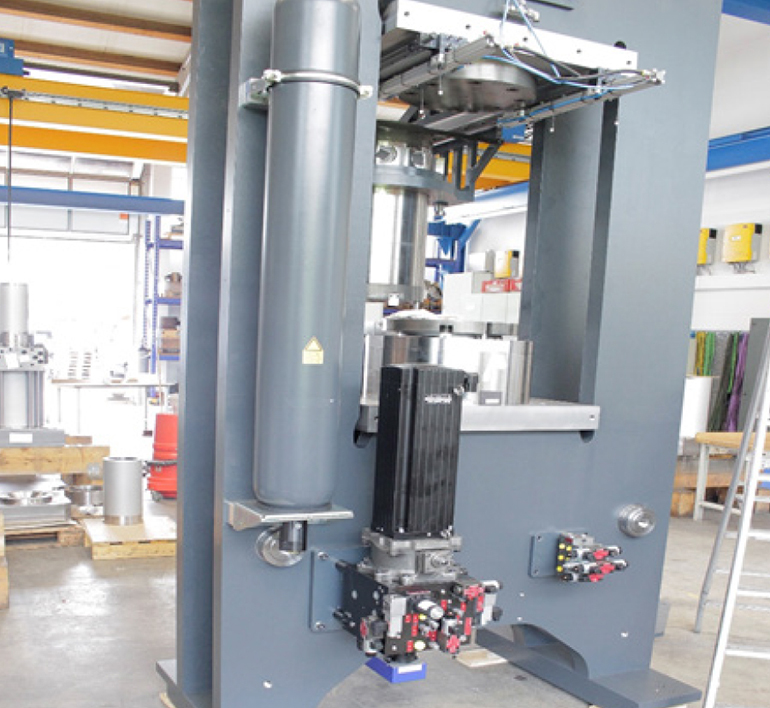Germany-based Frey & Co. GmbH sought technology to replace the hydraulic system in its EasyISO2000 4000-kilonewton isostatic press. The original design of the EasyISO2000 4,000-kN press included a traditional hydraulic system for five axes that Frey had used for many years. However, the solution required customers to call frequently for Frey & Co. to provide maintenance, and the design consumed high levels of energy; both were factors that ate away at Frey & Co.’s and its customers’ profitability and productivity.

Using Moog’s electrohydrostatic actuation system (EAS) on its isostatic presses allowed Frey & Co. to simplify machine design, increase efficiency, lower noise, and enhance product quality.
As a maker of adaptor tools, press machines and automation systems for the powder metallurgy sector, Frey & Co. provides applications for the medical, electronics, automotive and ceramics industries. The company’s employees focus on design, manufacturing and assembly processes. Frey’s EasyISO2000 isostatic presses produce ceramic parts with an even density distribution and long lengths. Cold isostatic pressing (CIP) is a materials processing technology where machines like the EasyISO2000 apply high pressures to ceramic powder in a sealed elastomer container, shaped specifically for the application. During the manufacturing process, the presses convert the powder from loose aggregate into a partly dense compact with enough strength to permit handling, before workers transfer the material to the next stage of the process.
Frey & Co. equips its EasyISO series presses with a pressure vessel, a pressure intensifier and a locking cylinder built into the press frame. The machines have a modular structure for press forces ranging from 2,000 to 10,000 kN, tailored to a customer’s needs. Frey & Co.’s designers can define each press between different pressures and component sizes. Depending on the type of aggregate powder a press owner uses, Frey & Co. fits the presses with dies that a customer can replace after each cycle.
The original hydraulic design was a classic system including a hydraulic power unit (HPU) with pump, filtration and cooling all based on conventional hydraulics. The many moving parts complicated maintenance for customers and caused more questions than necessary about operation. The press maker wanted to develop simpler, more efficient drive technology for its isostatic presses. After learning about an electrohydrostatic actuation system, or EAS, made by Moog Inc., Frey & Co. and Moog’s engineers met to discuss how the EAS with a function block and integrated, energy-saving electrohydrostatic pump unit (EPU) could control the EasyISO2000’s five press axes.

Moog’s EAS features a function block and integrated, energy-saving electrohydrostatic pump unit (EPU) that is 5 to 10 times smaller, including smaller filtration and cooling mechanisms, and a system that uses less oil and has fewer points of maintenance, than a traditional HPU-designed system.
The EAS solution is less complicated than Frey & Co.’s traditional design. It has an EPU that is 5 to 10 times smaller, including smaller filtration and cooling mechanisms, and a system that uses less oil and has fewer points of maintenance, so the machine is more stable. Frey & Co.’s original design employed an oil pump for pressure and a servo proportional valve for motion control. Powering this with hydraulics led to energy loss. Since the EAS is a closed system, there is no pressure drop, and that translates into energy savings depending on customer use. The EAS is also a direct-drive system between the cylinder and the pump, whereas, the original design required the system to cool oil, which draws additional energy.
With the EAS in place, Frey & Co. not only reduced the motion system’s and press’s size but also reduced the size of the HPU. By comparison, the EAS has a 70-liter oil tank reservoir and 32 cm3 EPU; the original design had an HPU oil tank measuring 400 to 500 liters with a 250 cm3 HPU.
With the EAS’s smaller tank there’s less need for cooling. The EAS controls the main axes of the EasyISO2000 press and all additional tool axes. The solution is made up of an EPU, manifold assembly, accumulator and a small auxiliary power unit.
Since installing the EAS in its EasyISO2000 press, Frey & Co. has reduced noise levels. The original system had an HPU running continuously, but the EAS generates noise only when the pump and cylinder move. The EAS causes less hydraulic noise because there is no sucking sound from a pump and building up of pressure inherent with the original design. With the closed-loop EAS, there are less parts, so less noise. When there is noise, it’s tied to the press creating pressure or force.
Because the press’ EPU delivers power only when needed, Frey & Co. says it has improved energy efficiency by more than 40%. This, in turn, has reduced operational costs. The amount of reduction depends, of course, on the operational requirements of each application in which the owner deploys a newly designed EasyISO2000, but savings between 10 and 40% is possible. In comparison to a classic hydraulic system, the EAS will always deliver some savings. Using the EAS in larger machines creates larger savings because the design reduces the number of materials, time to install and frequency of maintenance.
By replacing the hydraulic system on Frey & Co.’s EasyISO2000 with the EAS, the machine maker says its customers are also seeing higher quality ceramic parts due to greater stability in the production process. With the EAS, the press operator can more finely tune pressure and consistently hold it during production. This allows for more accuracy in creating ceramic parts. In the original machine layout, the press had an open-loop design that could not hold pressure as consistently for the press as the EAS. The EPU’s smaller oil requirement also improved C02 levels for the presses. Since there is less need to heat and cool oil and move fluid throughout the newly designed press, there is greater efficiency and less power consumption. This translates into less kilowatt-hour use and CO2 production with the EAS.
Moog
moog.com
Filed Under: Pumps & Motors